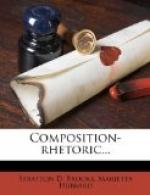[Footnote: To the Teacher.—Since the expression of ideas in metrical form is seldom the one best suited to the conditions of modern life, it has not seemed desirable to continue the themes throughout this chapter. The study of this chapter, with suitable illustrations from the poems to which the pupils have access, may serve to aid them in their appreciation of poetry. This appreciation of poetry will be increased if the pupils attempt some constructive work. It is recommended, therefore, that one or more of the simpler kinds of metrical composition be tried. For example, one or two good ballads may be read and the pupils asked to write similar ones. Some pupils may be able to write blank verse.]
+107. Purpose of Poetry.+—All writing aims to give information or to furnish entertainment (Section 54). Often the same theme may both inform and entertain, though one of these purposes may be more prominent than the other. Prose may merely entertain, or it may so distinctly attempt to set forth ideas clearly that the giving of pleasure is entirely neglected. In poetry the entertainment side is never thus subordinated. Poetry always aims to please by the presentation of that which is beautiful. All real poetry produces an aesthetic effect by appealing to our aesthetic sense; that is, to our love of the beautiful.
In making this appeal to our love of the beautiful, poetry depends both upon the ideas it contains and upon the forms it uses. Like prose, it may increase its aesthetic effect by appropriate phrasing, effective arrangement, and subtle suggestiveness, but it also makes use of certain devices of language such as rhythm, rhyme, etc., which, though they may occur in writings that would be classed as prose, are characteristic of poetry. Much depends upon the ideas that poetry contains; for mere nonsense, though in perfect rhyme and rhythm, is not poetry. But it is not the idea alone which makes a poem beautiful; it is the form as well. The merely trivial cannot be made beautiful by giving it poetical form, but there are many poems containing ideas of small importance which please us because of the perfection of form. We enjoy them as we do the singing of the birds or the murmuring of the brooks. In fact, poetry is inseparable from its characteristic forms. To sort out, re-arrange, and paraphrase into second-class prose the ideas which a poem contains is a profitless and harmful exercise, because it emphasizes the intellectual side of a work which was created for the purpose of appealing to our aesthetic sense.
+108. Rhythm.+—There are several forms characteristic of poetry, by the use of which its beauty and effectiveness are enhanced. Of these, rhythm is the most prominent one, without which no poetry is possible. In its widest sense, rhythm indicates a regular succession of motions, impulses, sounds, accents, etc., producing an agreeable effect. Rhythm in poetry consists of the recurrence of accented and unaccented syllables in regular succession. In poetry, care must be taken to make the accented syllable of a word come at the place where the rhythm demands an accent. The regular recurrence of accented and unaccented syllables produces a harmony which appeals to our aesthetic sense and thus enhances for us the beauty of poetry. Read the following selections so as to show the rhythm:—




